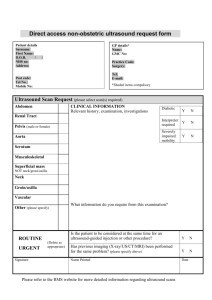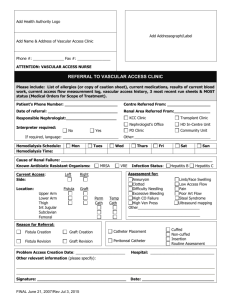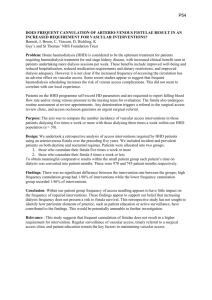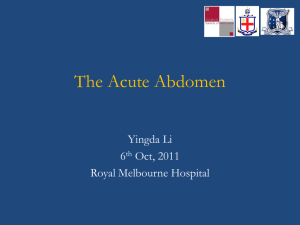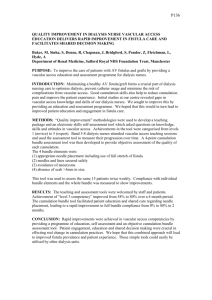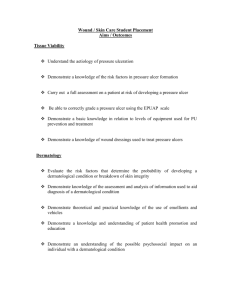Duplex ultrasound assessment of Prosthetic arterio
advertisement
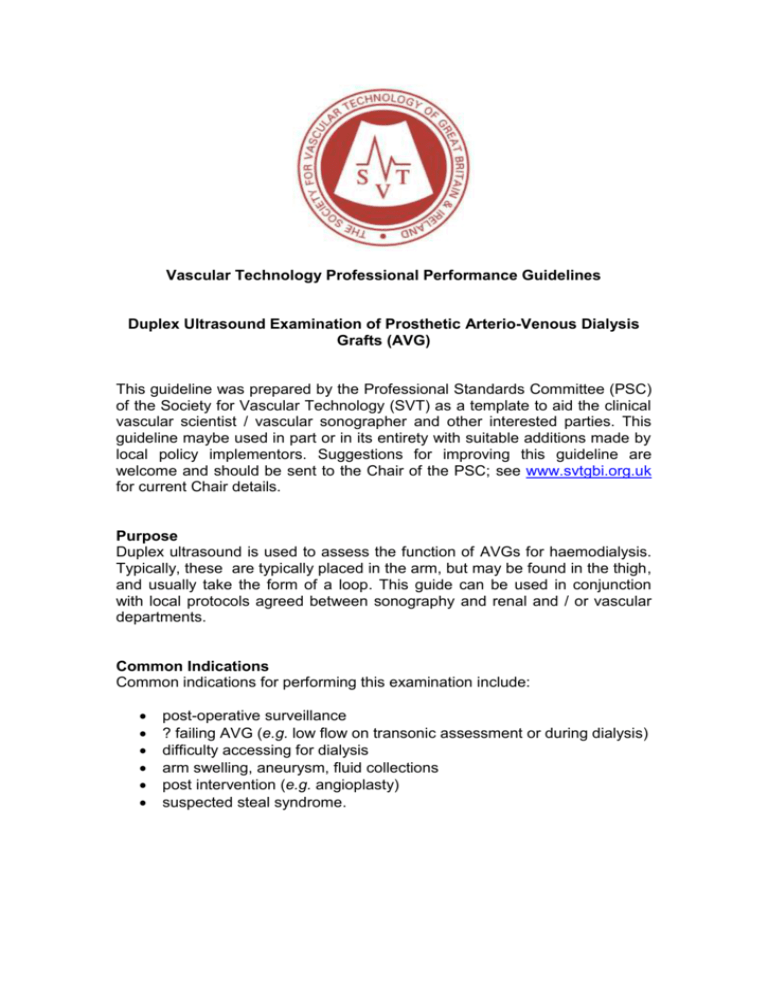
Vascular Technology Professional Performance Guidelines Duplex Ultrasound Examination of Prosthetic Arterio-Venous Dialysis Grafts (AVG) This guideline was prepared by the Professional Standards Committee (PSC) of the Society for Vascular Technology (SVT) as a template to aid the clinical vascular scientist / vascular sonographer and other interested parties. This guideline maybe used in part or in its entirety with suitable additions made by local policy implementors. Suggestions for improving this guideline are welcome and should be sent to the Chair of the PSC; see www.svtgbi.org.uk for current Chair details. Purpose Duplex ultrasound is used to assess the function of AVGs for haemodialysis. Typically, these are typically placed in the arm, but may be found in the thigh, and usually take the form of a loop. This guide can be used in conjunction with local protocols agreed between sonography and renal and / or vascular departments. Common Indications Common indications for performing this examination include: post-operative surveillance ? failing AVG (e.g. low flow on transonic assessment or during dialysis) difficulty accessing for dialysis arm swelling, aneurysm, fluid collections post intervention (e.g. angioplasty) suspected steal syndrome. Contraindications and Limits Contraindications or limits for AVG examination include: wound dressings recent bleeding from the access site very tortuous or eroding graft patients unable to cooperate due to impaired cognition (e.g. dementia) or from involuntary movements. Equipment Duplex Doppler ultrasound machine with imaging frequencies of 4 to 12MHz, with linear and curvilinear transducers available. Doppler frequencies of at least 5.0MHz should be available, with colour Doppler capability. Imaging equipment should be capable of calculating volume flow rates and recording images. Compliance with the Medical Devices Directive is necessary. Electrical safety testing is required annually, with regular maintenance and quality assurance testing to a specified level by qualified personnel. Review of in-service equipment should typically be undertaken four to six years after installation1. The examination couch should be height adjustable and preferably electrical. The Clinical Vascular Scientist’s (CVS) chair should provide good lumbar support, be height adjustable and allow the CVS to move close to the examination couch2,3. The examination room should be temperature controlled with adjustable lighting suitable for the examination4. Suitable cleaning materials should be available and used in line with manufactures’ guidelines2. Explanation of Examination and Patient History The CVS undertaking the examination should: introduce themselves confirm the patient’s identity (e.g. full name and date of birth) explain why the examination is being performed, the procedure and its duration (consideration should be made to the patient’s age and mental status) obtain a relevant medical history from the patient and / or notes, including; o Presence of risk factors impaired graft function aneurysm intervention to the arm thrombosis o results of other relevant diagnostic tests and previous vascular studies complete a limited physical examination, observing the presence of any signs, previous surgery or vascular injury verify the requested procedure correlates with the patient’s clinical requirements Examination The patient is asked to remove their clothing to expose the arm. They are examined supine; head and shoulders can be raised. The arm to be examined may be abducted to nearly 90 degrees and the arm rested on the CVS’s lap / pillow. To avoid stretching, the examination couch may be rotated to allow easy access to the body. Due to the intimate nature of the examination it may be necessary to offer a chaperone5. During the examination, monitor the patient’s mental and physical status and modify the examination accordingly. In addition to the AVG, the following vessels may be assessed: subclavian artery axillary artery brachial artery common femoral artery profunda femoris artery superficial femoral artery internal jugular vein brachiocephalic vein subclavian vein axillary vein brachial veins common femoral vein profunda femoris vein superficial femoral vein. The following imaging modes should be used to evaluate the fistula circuit: B-mode assess anatomy; aneurysms, peri-fistula fluid (e.g. pseudoaneurysm, seroma), stenoses and abnormal vessel contents measure aneurysms in transverse access sites for accurate placement of needles fistula depth Colour and Spectral Doppler determine presence / absence of flow, its direction through the fistula circuit and flow distal to the fistula quantify volume flow rates identify abnormal flow patterns and quantify stenoses assess pseudoaneurysms. Pre-Operative Vessel Suitability: For general details on assessing artery and vein suitability for fistulae prior to surgery, please refer to the SVT Professional Performance Guideline: Duplex Ultrasound Examination Prior to Native Arterio-Venous Fistula Formation: upper limb. There is little data in the literature specifying suitable artery and vein diameters for an AVG, but it has been stated a vein with a diameter of at least 4.0mm is required10,11, and a minimum arterial diameter of 2.0mm11. Examining the AVG: It is best to assess a fistula before dialysis. Examine the entire fistula circuit, from arterial inflow to distal venous outflow, attempting to image the subclavian and brachiocephalic veins in arm fistulas. Pay particular attention to the anastomoses (especially at the venous end of the graft), perianastomotic region, dialysis access sites, graft wall integrity and any areas of aliasing. Suspect a loss of graft wall integrity or severe outflow stenosis if an haematoma or pseudoaneurysm is present. Loss of graft wall integrity, interstitial and peri-graft fluid are common indicators of graft infection. Volume Flow Rates (VFR) Normally, high velocity flow and low resistant waveforms are encountered in a fistula and its ‘feeding’ artery. To maintain patency, VFRs in a graft should be higher than for native fistulae8,9, possibly in excess of 800mL/min8. A VFR of <500mL/min is considered abnormal9, and </=600mL/min indicates impending risk of thrombosis7. VFR may be considered pathologically high if exceeding around 2L/min in conjunction with symptoms (e.g. shortness of breath.) VFRs can be assessed in the feeding artery and in the fistula just distal to the access site, and should also be estimated distal to any stenoses or in prominent branches to determine their effect on flow. Image in longitudinal in B mode, ideally in a uniform calibre segment where there is no turbulent flow. Using spectral Doppler, a waveform that typifies flow here is chosen for mean velocity calculations, and Doppler gain is adjusted to minimise spectral broadening; mean velocity is calculated over at least three cardiac cycles9. It is essential the Doppler gate traverses the area of flow, Doppler angle is <60 degrees and vessel diameter callipers accurately match the vessel diameter (measured 90 degrees to vessel walls.) As there are inherent errors in measuring VFR, the average of at least three VFR values should be stated in the report9. The ultrasound machine calculates VFR using the following formulae: Cross Section Area (CSA, cm2) = diameter2 (cm) x π/4, assuming the vessel is circular Mean velocity (cm/s) is calculated over at least three cardiac cycles VFR (mL/min) = CSA x mean velocity x 60. Stenosis Doppler angles must be kept below 60 degrees. Areas of aliasing or reduction in calibre should be examined for a stenosis. A velocity ratio of 2:1 (intra stenosis / pre stenosis velocity) indicates a 50% stenosis in a straight section of the feeding artery, the outflow veins, and in the AVG (but not necessarily at its anastomoses.) Stenoses are more difficult to grade at a fistula anastomosis, where there is often acute angulation or disparity between inflow vessel and fistula calibres. Here, velocities often normally measure around 300 to 500cm/s, and It is has been suggested a two fold increase in velocity indicates at least a 50% stenosis9, and a two to three fold or greater ratio suggesting a more severe (>50%) stenosis.7,9, 12, 13 However, large changes in vessel calibre and angle, with corresponding flow changes, are common and may have subclinical significance7; general and local flow data and clinical presentation must be matched to give an overall picture of fistula function. The residual lumen calibre at a stenosis can be carefully measured in transverse. Steal syndrome Steal syndrome is diagnosed clinically, and ultrasound can provide haemodynamic evidence to support this8 (It is common for there to be non pathologic flow reversal in the brachial or radial artery distal to a fistula.) Colour and spectral Doppler are used to assess waveforms and flow direction in the arteries perfusing the limb distal to the arterial (proximal) end of the AVG. VFR in the radial and ulnar arteries can be assessed. Photoplethysmography can aid in demonstrating reduced flow in fingers. Reporting The report is a record of observations and interpretations made during the duplex ultrasound examination. It should be written by the CVS undertaking the examination and viewed as integral to the whole examination5. The report should include: correct patient demographics; examination type and date; name and status of the CVS correct side and which type of AVG is present which vessels were examined, their patency and general flow, fistula calibre and depth presence and location of any abnormality fistula +/- feeding artery VFR, degree of any stenosis, occluded segments, flow quality and direction anything limiting the examination a note of any follow up or referral as a result of the scan an appropriate number of annotated images representing the entire ultrasound examination, in accordance with local protocols and SVT Image Storage Guidelines4. Referral of urgent results should be made to the referring consultant and / or appropriate medical / surgical team as per local protocol, so treatment plans can be developed, enforced or expedited accordingly. RESOURCES: Society for Vascular Ultrasound; Vascular Technology Professional Performance Guidelines; Evaluation of Dialysis Access 2012 www.svunet.org Society for Vascular Ultrasound; Vascular Technology Professional Performance Guidelines; Upper Limb Extremity Vein Mapping for Creation of a Dialysis Access or Peripheral Vascular Bypass Graft 2012 www.svunet.org Society for Vascular Technology Physiological Measurement Service Specifications; Duplex Assessment and Surveillance of Arteriovenous (AV) Fistula (pre and post fistula formation) www.svtgbi.org.uk REFERENCES: Standards for Ultrasound Equipment; Royal College of Radiologists, February 2005 www.rcr.ac.uk 2 Guidelines for Professional Working Standards Ultrasound Practice; United Kingdom Association of Sonographers (UKAS) October 2008 www.sor.org/learning/document-library 3 The Causes of Musculoskeletal Injury Amongst Sonographers in the UK; Society of Radiographers, June 2002 www.sor.org/learning/document-library 4 Society for Vascular Technology Professional Standards Committee Image Storage Guideline April 2012 www.svtgbi.org.uk 5 Society for Vascular Technology Professional Standards Committee Chaperone Guidelines April 2012 www.svtgbi.org.uk 6 Ferring M, Henderson J, Wilmink A, Smith S. Vascular ultrasound for the pre-operative evaluation prior to arteriovenous fistula formation for haemodialysis: review of the evidence. Nephrology Dialysis Transplant (2008) 23: 1809-1815 7 Freedman B, Deane C. Ultrasound in Haemodialysis Access. Ultrasound (2005) 13:2 86-92 8 Cullen N, Powell S. Interpretation of duplex in Arteriovenous dialysis access: a review of pathologies. Ultrasound 2011; 19:76 - 84. 9 American Institute of Ultrasound in Medicine Practice Guideline for the Performance of a Vascular Ultrasound Examination for Postoperative Assessment of Dialysis Access 2007 www.aium.org 10 American Institute of Ultrasound in Medicine Practice Guideline for the Performance Ultrasound Vascular Mapping for Preoperative Planning of Dialysis Access; 2011 www.aium.org 11 Allon M, Robbil M.L. Increasing arteriovenous fistulas in haemodialysis patients: Problems and solutions; Kidney International, Vol. 62 (2002), pp 1109 – 1124 12 Older RA et al. Haemodialysis access stenosis: early detection with colour Doppler. US Radiology 1998 Apr; 207(1):161-4. 13 Robbin ML et al. Haemodialysis access graft stenosis: US detection. Radiology. 1998 Sep; 208 (3): 655-61. SVT Professional Standards Committee April 2014
